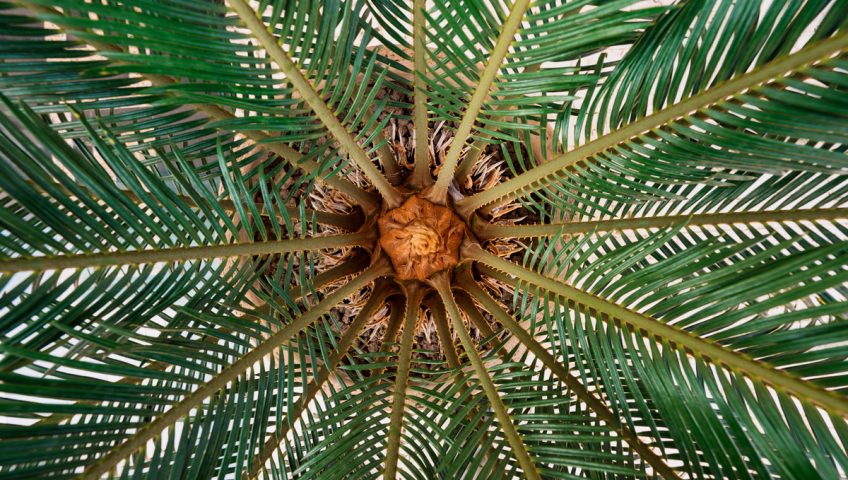
Palm Tree Care
How can you care for your palm trees throughout the year? Follow our guide to properly care for your trees and guard against any potential pests and/or diseases.
Palm Tree Care Tips
Routine maintenance is needed to keep your palms at maximum health. Use these care tips below:
Soil
Compacted soil found in many urban areas does not offer the type of nutrients required for a palm tree to thrive. These trees actually acquire a lot of their nutrients from the top of the ground and topsoil. This means fertilization is needed.
Roots
Since these roots do not grow very deep into the ground, they will require occasional care. The majority of palm trees feature just one trunk. The point at the top of the trunk is known as the terminal bud. If the top gets damaged, the tree could die.
Watering
Water a new palm tree twice per week for the first six months of life. Add enough water to penetrate at least 18 inches of the soil. If the soil is sort of a sandy mix, extra water is needed. Watering requirements for older palm trees will depend on the climate.
Pruning
Yellowing or browning fronds should be removed, but refrain from trimming too close to the palm tree trunk. Bark can be easily damaged and any wounds will be used as entry points by potential pests and diseases. As new fronds grow, the older ones will die off.
Palm Tree Diseases
Inspect your palms often to watch for any potential diseases.
Bud Rot
This is a fungi that can cause the fronds to wilt and eventually perish. Total demise of the tree may follow afterwards. Mexican and California palms are especially vulnerable to bud rots.
Lethal Yellowing
First observed in the Caribbean area nearly 100 years ago, this disease eventually saw a massive outbreak in the Florida Keys and Jamaica.
Fusarium Wilt
This disease causes the fronds to start wilting, eventually losing their green color and die. When a palm gets infected, there is really no remedy for this disease.
Ganoderma Butt Rot
A newer fatal disease of Florida palms, it is caused by a fungus called Ganoderma zonatum. This will attack the base or “butt” of the tree at a height of 3-4 feet above the ground. This disease has been attacking palms since 1994.
Palm Tree Pests
Always be mindful of these potential threats to your palms.
Palm Budworm
This is a type of beetle whose larvae feeds on flowers of a large range of fan palms. These beetles are about an inch long and are pink and green in color.
Royal Palm Bug
These pests will feed on only the royal palms, but females will lay one egg a day there during the spring. They will rarely kill the tree, but they will cause considerable damage.
Giant Palm Borer
This is a large beetle that targets the wood of Phoenix and Washington species. The borer grubs can survive inside palm trees for up to 9 years.
Thrips
This is a significantly large family of insects, feeding on palm flowers and leaves. While they aren’t lethal to palms, they will cause discoloration. You may start to notice black droppings on the leaves, as well.
Palmetto Weevil
They are found in Florida, Texas and South Carolina. They have a record of infesting saw palmettos, Washington palms, Canary Island date palms, royal palms, and even coconut palms.
Liberty Tree Care Offers Tree Services in Scottsdale, Mesa & Tempe
If you are searching for tree service in Scottsdale, Mesa or Tempe, Liberty Tree Experts can help! Get a free tree service quote by giving Liberty a call today at 480-482-9374.
More Articles About Arizona Trees
- Should I Skin My Palm Trees?
- Arizona Shade Trees That Don’t Shed
- Is My Palm Tree Dead?
- Best Time Of Year To Trim Trees In Arizona
- Can You Grow Lemon Trees In Arizona?
- How To Save A Dying Cactus
- How To Bring A Dead Palm Tree Back To Life
- Cost Of Tree Removal 2020
- How Much Does Cactus Removal Cost?
- How Much Does Palm Tree Trimming Cost?
- How Much Does Palm Tree Removal Cost?
- How Much Does Tree Removal Cost?
- How Much Does Tree Stump Grinding & Removal Cost?
- How To Trim A Tree
- How To Choose a Tree Service
- WHY TOPPING HURTS TREES
- How To Show Your Trees You Love Them
- Fast Growing Trees of Arizona
- When & How to Trim Citrus Trees in Arizona
- Preparing Arizona Trees For Monsoon Storms
- Arizona Ash Trees
- Mesquite Trees In Arizona
